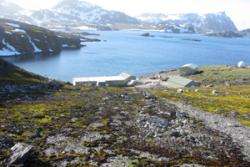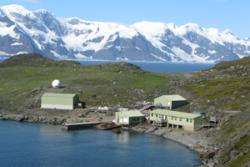Antarctic flowering plants warm to climate change

(PhysOrg.com) -- The first issue of a new journal in the prestigious Nature series, Nature Climate Change (issue 1; April 2011) highlights how one plant species in the Antarctic appears to be taking advantage of climate change.
Bangor University scientist and the paper’s lead author, Dr. Paul Hill explains: “We think of the Antarctic as a land of snow and ice. But, in summer on the Antarctic Peninsula, and the islands surrounding the frozen centre of the continent, the snow melts and many areas become green with mosses and two species of native flowering plant. Recently, as global temperatures have increased, and Antarctic summers have become longer and warmer, one of these flowering plants, Antarctic Hairgrass (Deschampsia antarctica), has become increasingly widespread.”
A team of UK and Australian scientists led by Professor Davey Jones of Bangor University’s School of the Environment, Natural Resources and Geography may have discovered the secret to the success of this plant. The team carried out research funded by the Natural Environment Research Council in collaboration with British Antarctic Survey at its Signy Research Station in the Southern Orkneys. Signy is an isolated island that has a well-established record of climatic warming over the last 50 years.
Prof Davey Jones explains: “Plants need nitrogen to grow successfully. In coastal Antarctica, most of the nitrogen is locked in organic matter in the soil, which has been slow to decompose in the cold conditions. This is now becoming more available as temperatures increase”.

Professor Jones’ team made the discovery that Antarctic Hairgrass can use its roots to access this nitrogen much more efficiently than has previously been shown in plants. Consequently, in the struggle to find the nutrients needed to exploit the sunlight of the brief Antarctic summer, this grass has a key advantage over the mosses, with which it competes for resources. However, Professor Jones concedes that it may be some time before Antarctic bases need to invest in lawnmowers.
These findings show that some plants use nitrogen in a form that has not previously been recognised as important. Consequently, they also have significant implications for the sustainable management of agricultural and natural ecosystems in many other parts of the world. The discovery of a new cog in the terrestrial nitrogen cycle should help us to use fertilisers more efficiently and to better understand the implications of anthropogenic nitrogen pollution and ecosystem responses to climate change.
More information: “Vascular plant success in a warming Antarctic may be due to efficient nitrogen acquisition” by was published in Nature Climate Change on 29 March. doi:10.1038/NCLIMATE1060
Provided by Bangor University


















